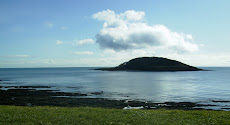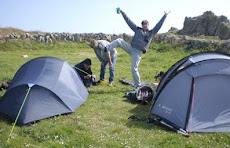Now ever think that there might be a better use for those £1000 bins you see round the necks of bird spotters who plainly are a little challenged in the ID department? I well remember being sat at Leighton Moss next to one such expensively equipped and well spoken gentleman when the following conversation ensued (and this is verbatim)
He: "Oh, excuse me, what's that, that bird there?"
Me (always eager to provide advice): "That's a Lapwing".
He: "Ah, Lapwing......oh yes....very aptly named"
Pause
He: "Oh, oh, what's that bird there, that one with the long skewer, the long skewer like bill"
Me: "Ermm, that's a black headed gull carrying a stick"
I was so tempted to tell him that his Swarovski bins were rubbish and he should swap them for whatever russian things I was sporting at the time.
Anyway, fret no more. For I have the answer. For those who find that their t op of the range kit still doesn't make it any easier to identify a stick carrying bird, there is an alternative pursuit. Check out http://www.youtube.com/watch?v=cwvVh0_ZelI. This is absolutely hilarious and I think would also add a bit of spice to the annual birders vs locals footy match on the Scillys.
op of the range kit still doesn't make it any easier to identify a stick carrying bird, there is an alternative pursuit. Check out http://www.youtube.com/watch?v=cwvVh0_ZelI. This is absolutely hilarious and I think would also add a bit of spice to the annual birders vs locals footy match on the Scillys. My only birding today had to fit around work (writing a local economic assessment of Somerset as it happens - no I thought you wouldn't be interested). It was blowing a gale and squally in the morning and I weighed up going to Hannafore then and working later (always dangerous) or getting a few hours under my belt and then heading off late afternoon for high tide. Opted for the latter, and as the afternoon wore on the sun came out, the wind dropped so that by the time I reached Hannafore there was nothing but a gentle breeze and bright sun. This also meant that the promenaders were out in force. Scoping the horizon showed there were plenty of Gannet out there but nothing moving closer in. Still 2 Slav Grebe and 2 Great Northern Diver, as well as a drake Common Scoter in the bay, and a Great Crested Grebe. At one point a GN Diver and Great crest passed in close proximity, the diver dived (very aptly named) and immediately surfaced right by the grebe and took up an aggressive outstretched necked position, causing the grebe to scarper pronto. You don't appreciate how big a great northern is until you see it alongside another bird. A different (or remarkably quick moulting) immature male Eider was also about, and 4 Med Gulls (1 adult, 2 2nd winter and 1 3rd winter). However, probably the best patch bird was a lone Bar tailed Godwit roosting with the oystercatcher and Turnstone.
 op of the range kit still doesn't make it any easier to identify a stick carrying bird, there is an alternative pursuit. Check out http://www.youtube.com/watch?v=cwvVh0_ZelI. This is absolutely hilarious and I think would also add a bit of spice to the annual birders vs locals footy match on the Scillys.
op of the range kit still doesn't make it any easier to identify a stick carrying bird, there is an alternative pursuit. Check out http://www.youtube.com/watch?v=cwvVh0_ZelI. This is absolutely hilarious and I think would also add a bit of spice to the annual birders vs locals footy match on the Scillys. 







My invented name for these people is "boobtubers".... big, expensive tube ( telescope) but still making lots of mistakes ( boobs). Or as Judith Swift put it, "all the gear but no idea."
ReplyDeleteI'm quite pleased with it and want it to catch on.
If anyone wants to see all the other invented birding terms I have come up with... well, a sample of them.... they can look at mostlybirdingwithray ... the post is called nwbw .... I can't remember the rest of what it was called.
You will find out all about Kikis, Kerbys, Mozzers, nwbws, slaloms etc etc.
You seem to have quite a decent patch there Adrian.
Best wishes from Ray.